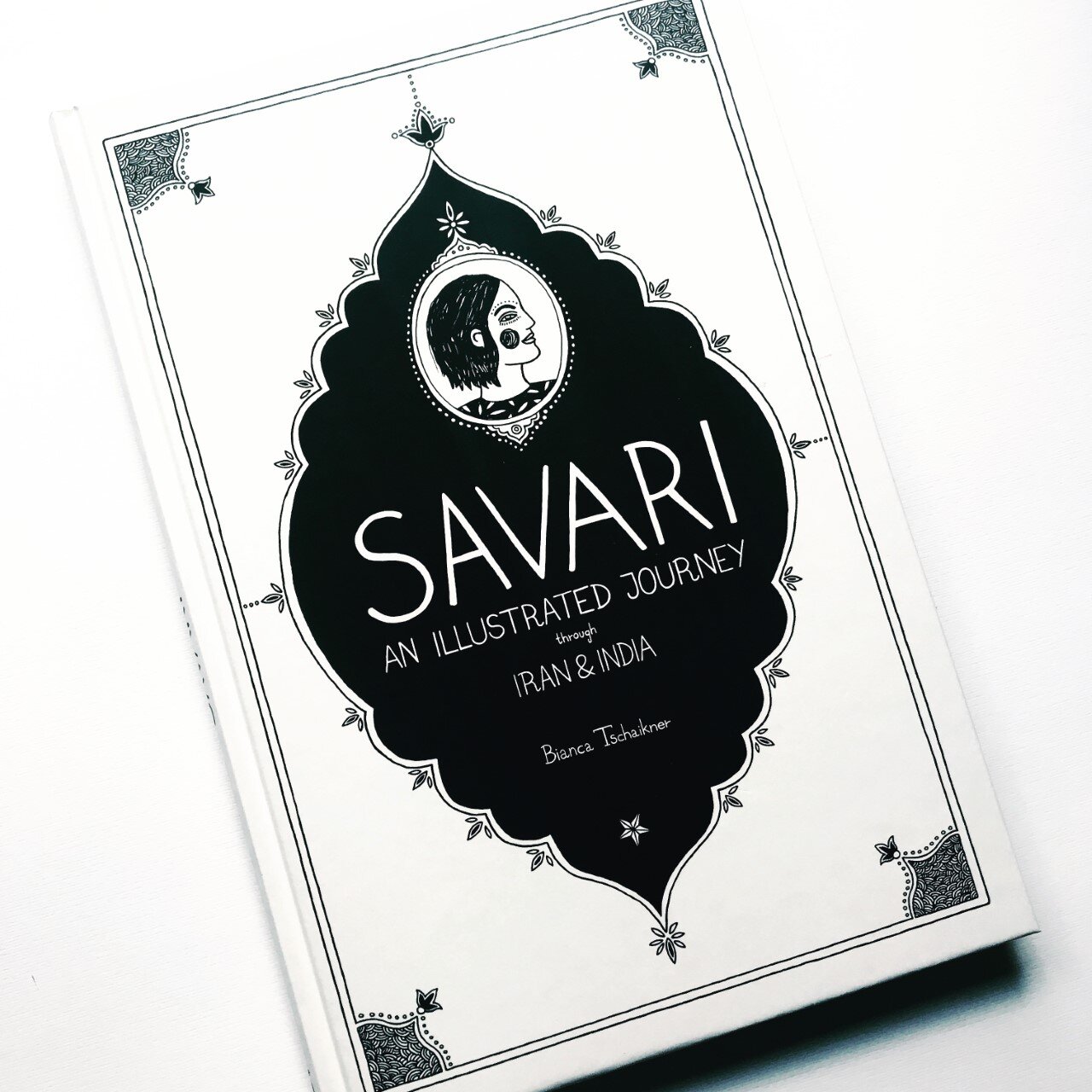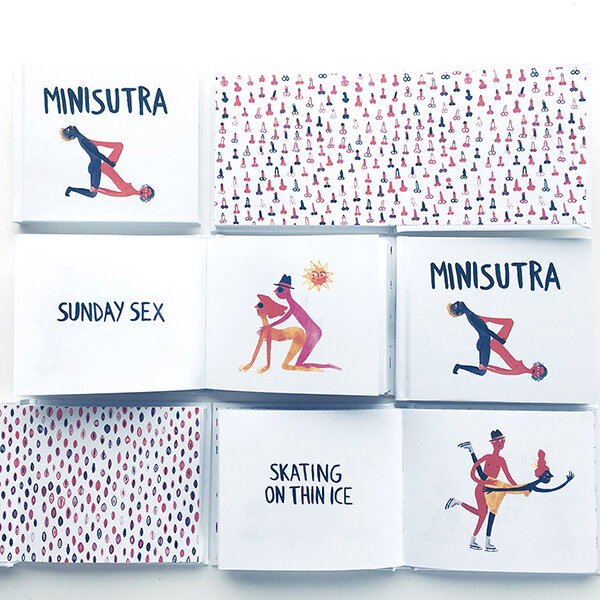From Around the World: The Illustrations of Bianca Tschaikner

Photo: Bianca Tschaikner / Rachele Salvioli
Bianca Tschaikner is an Austrian illustrator, printmaker and storyteller with a nomadic spirit. Her books and artworks are inspired by her numerous travels to countries such as India, Pakistan, Indonesia, Iran, Malta, Italy, Jordan, and Spain, where likes to immerse herself for extended periods of time in the search of stories, images and atmospheres. Here she takes us through her amazing adventures.
In my early twenties, I lived in Morocco for some time. One night, I got robbed in the Marrakech express. Everybody was asleep except me, and when the train stopped in Meknes, a guy jumped into the compartment and tore my bag away from me. There was nothing of great value in it – except my sketchbook.
It was the first sketchbook I had been working on with some amount of dedication – and I was devastated. I remember I even chased the robber on the nightly train tracks, but I didn’t catch him – thank god. Back from my unlucky trip, I got myself a new sketchbook – that is, a thick leather-bound Arabic calendar which was the most suitable book I could find – and I decided to create a new sketchbook that would be a million times better than the lost one. I became super ambitious to capture the weird and wild life in Tangier with everything going on in its shady coffee houses and bazaars and gloomy bars and soon found myself drawing constantly.
This was the jump start for what I’m doing today, exploring the world with my sketchbook.
The first sketchbook I published was one from a journey through Iran and India. Before that, I didn’t really show my sketchbook to anyone. But in Iran, I felt really connected to the people, and I felt their enormous love and understanding for art and poetry, something I hadn’t encountered anywhere else in that form.
People throughout my journey really had fun with my sketchbook and suggested to publish it – and so eventually I did, under the title “SAVARI - an illustrated journey through Iran and India”.
SAVARI spans over four months and 24.500 kilometers, from surreal conversations in the tea houses of Shiraz and Esfahan, to printmaking in the jungle of Baroda, to partying in Bollywood and eating insects in the Wild East of India.
It was a magical, dream-like journey which I documented and reflected for myself in my sketchbook – so SAVARI is certainly is my most personal work.
I like to think of an artist less as a creator but more as some kind of medium. I feel that the atmospheres and stories I perceive go through me onto the paper – it’s a state of flow and I enjoy drawing the most when I don’t even know myself what I’m going to draw, when I simply let myself lead by the pen. So I really enjoy working intuitively. For me observing my own images unfolding without following much of a plan is some kind of delicious entertainment for myself.
I love the feeling of being in a state of serendipity. I just walk around for hours, observing what all is going on, then sit down here and there, grab my sketchbook and see what emerges between my surroundings and myself.
I’ve spent days and days like this and for me, exploring the world in that way is one of the most beautiful ways to be alive.
One of my most beautiful “workplaces” in that sense was the city of Udaipur in Rajasthan, India, also called “Venice of the East”.
Udaipur is a fantastic fairytale city full of swimming palaces, a labyrinth of lakes and bridges and millions of intricate alleyways leading to mysterious temples, the home of countless goddesses and gods.
I stayed there for two months and filled a 3m long leporello book with a partly imaginary, partly real panorama of this wonderful and surreal city.
Two years later, I had it printed in India as a beautiful handmade edition with a golden screenprint cover, LAKE CITY.
Together with LAKE CITY, I printed another sketchbook I made during a stay with the Khasi tribe. The Khasi live in Meghalaya, a remote area in Northeast India, and what is so special about them is that they are matrilineal and matrilocal, which means the family lineage is passed down from mother to daughter, everything belongs to the women, and the husband moves to the wife’s home – so it’s a whole different system, although one cannot imagine it simply as a “reversed” patriarchy.
What I loved most about Meghalaya was its incredible richness of fascinating folktales – in my book there are stories about forests inhabited by spirits, living mountains fighting with each other, and then lots of weird everyday stories like a whole village being arrested for having a tiger barbecue.
Another book I made in the last years is MINISUTRA. It’s a tiny little book which takes a humorous twist on the ancient Kamasutra.
It was born from a Kamasutra advent calendar I made on facebook some years ago when I was in dark and gloomy Scotland, counting the days to spend Christmas in India so to make the waiting easier, every day I posted a funny (and often totally impracticable) sex position. It was great fun, especially the comments I got from people.
Most of the books I made so far are in some way inspired by India.
It is one of my favourite countries in the world, it is dense and intense in every way, and if I don’t go there regularly, I get really homesick for it, although it also really makes me crazy sometimes.
Recently, I started to work with papercut. Last fall, I was in Valletta, Malta, where I worked on my project “The City of Open Windows”, creating papercut posters inspired by stories I was told by the inhabitants of Valletta, sticking them to the places they are referring to and then creating some kind of storytelling city tour. I found lots of dramatic stories of sailors and nuns and war and love, but also some fun ones, like the story of an artist so dedicated that he would go to the port to paint during an air raid. Valletta is a treasure chest of history and of stories, very dense and very dark, and it was extremely interesting to work there, but also a pretty intense time as I had only two weeks.
In the last years, I also started painting murals. I was invited to an artist residency in the little Catalonian village Riba Roja d’Ebre and they invited me to paint old doors. This project was centered around Teresa Águila, who started life as some kind of female Oliver Twist and became a really impressive personality who was persecuted by the Franco regime – she died a long time ago, but I was lucky to meet her grandson who told me everything about her.
Since then, I’ve been really into exploring small villages, which to me are microcosmoses full of fascinating stories. There is a certain magic in villages, a magical web of stories you can’t find in that form in cities, where things are more disconnected.
Last summer I found that magic again in the really small village of Castagno di Pitecchio in Tuscany, where I was invited as an artist in residence and where I created my artist book A Cottage of Wind, in which impressions of the dreamy Tuscan nature collide with the war memories I was told by old villagers.
And to also leave something in this lovely village which had welcomed me and the other artists into their community with open arms, sharing with us their stories, pizza and wine, I painted a mural of two hula hooping village girls, Greta and Emma, on the house of one of the girl’s family.
This is one of the most beautiful aspects of my work, the connections I can make through it, and that through my work sometimes I can give something back to the places and people who share their lives and stories with me. This circle of sharing and connecting is completed for me when I host my storytelling evenings, where I tell the stories of my sketchbooks and artworks, letting my audience immerse themselves into all of these marvelous worlds that I explored.
Another country where I collected lots of stories was Pakistan, which I visited twice in the last years. Pakistan is definitely not an easy country to travel to, but it has the most amazing storytellers.
The first time I came there with my hand broken so I could not really work, but the second time I worked a lot and made a series of watercolors illustrating a few of the stories I heard – and I still have lots of material left.
My watercolor painting “The disobedient children of Lahore” was inspired by a small ad I found in a Pakistani Newspaper:
“It is notified for the information of general public that my son Malik and my daughter Manahil are disobedient and rebellious. Due to family clash I disown them to inherit all my properties and assets. Muhammad M., Karachi”
After my stay with the Khasi in India, I became very interested in matriarchal cultures and this winter, I visited the Minangkabau in West Sumatra, who also have a tradition of matrilineality.
In their traditional way of life, which is now slowly disappearing, women would live together in houses, while the sons of the family would spend night in the mosque from a very young age, and the husbands of the women of the house also would only stay with them at night.
Minangkabau means “victorious buffalo”, and the importance of the buffalo is reflected in the traditional houses of the Minangkabau whose roofs are shaped like buffalo horns, and in the traditional horn-like headgear of women. I had planned to stay longer in Indonesia but then Coronavirus happened and I had to leave in a rush – since my return, I’ve been in Austria, waiting until I can travel again.
Today, I’m grateful to the robber in the Marrakech Express for unleashing that creative force in me.
This incident taught me that often when something apparently bad happens, you can twist it and around use it as a chance for something really beautiful to be born out of it.
I still remember how upset I was that night in the train – but today, this story – like many other bigger or smaller dramas from my journeys – makes me smile.
And I don’t even remember a single page from that stolen sketchbook.
Editor, artworker and lifelong bibliophile.















